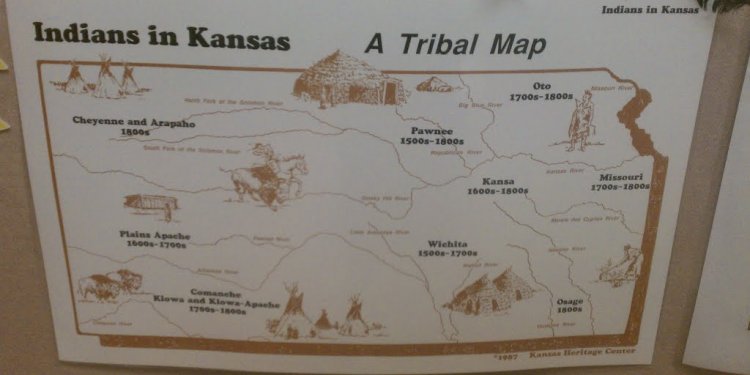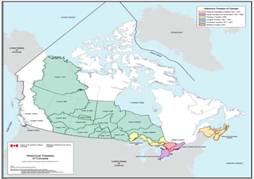
Native tribes of Canada map
 Pre-1975 Treaties of Canada (PDF, 1.58 Mb)
Pre-1975 Treaties of Canada (PDF, 1.58 Mb)
Map illustrating the Pre-1975 Treaties of Canada
Map of Canada in 1871 (PDF, 1.62 Mb)
Treaty #5. This treaty originated in two historical procedures. The southern part, negotiated in 1875, ended up being among the south Prairie treaties, and was in big part due to the insistence for the Native individuals of that area that their Aboriginal liberties be recognized by the Canadian government, which had recently obtained title with their lands. The northern element of Treaty 5 was negotiated in 1908.
Map of Canada in 1873 (PDF, 1.59 Mb)
Treaty No. 3. After three-years of negotiations, the Dominion of Canada plus the Saulteaux tribe of Ojibway Indians joined into treaty in the North-West Angle associated with the Lake of this Woods. Aided by the Saulteaux surrendering subject to a place of 14, 245, 000 hectares, Canada obtained land for farming, settlement and mineral development. Moreover, Canada protected communications utilizing the North-West Territories, including the route into the future Canadian Pacific Railway.
In 1873, Prince Edward Island enters Confederation, bringing the sheer number of provinces within the Dominion to seven.
Map showing Treaties 1, 2, 3, 4, 5 and 6
Map of an element of the North West Territory, including the Province of Manitoba. Exhibiting the several Tracts of Country ceded because of the Indian Treaties 1, 2, 3, 4, 5, and 6.
Map showing Treaty No. 3
Map of an element of the Dominion of Canada showing Treaty #3.
Map of Canada in 1874 (PDF, 1.61 Mb)
Treaty No. 4. Initiated by Indians and Métis concerned about the decreasing numbers of creatures which offered these with a full time income. Treaty 4 covers present-day south Saskatchewan. Provisional boundary set-in northern Ontario.
Map of Canada in 1875 (PDF, 1.61 Mb)
Treaty #5. This pact started in two historic processes. The south part, negotiated in 1875, had been among south Prairie treaties, and was at large component a result of the insistence of the Native people of that region that their Aboriginal rights be acquiesced by the Canadian government, which had recently acquired subject for their lands. The northern element of Treaty 5 had been negotiated in 1908.
Map of Canada in 1876 (PDF, 1.62 Mb)
Treaty #6 - The settlement for this pact were held during a challenging duration the flatlands Cree, who were enduring the rapid decline associated with the buffalo. The documents indicate that their problems included health care bills and relief in the event of need.
Map of Canada in 1877 (PDF, 1.62 Mb)
Treaty No. 7. the very last associated with numbered treaties negotiated and signed through the 1870s. The treaty covers the south part of present-day Alberta.
Treaty No. 8 area
Map showing the territory ceded under Treaty number 8 additionally the Indian tribes.
Map of Canada in 1899 (PDF, 2.00 Mb)
Treaty Number 8. 1st for the north treaties covered a place of 324, 900 sq miles and signifies more geographically substantial treaty activity undertaken. It comprises what's today the northern half of Alberta, the northeast quarter of British Columbia, the northwest part of Saskatchewan, as well as the area south of Hay River and Great Slave Lake when you look at the Northwest Territories.
Map of Canada in 1905 (PDF, 2.00 Mb)
Treaty No. 9. Responding to continuous petitions from the Cree and Ojibwa people of northern Ontario, plus in preserving its policy of paving just how for settlement and development, the government in 1905-1906 negotiated Treaty 9, also known as the James Bay Treaty. The first and just time, a provincial government took an energetic part in negotiations. Alongside the area acquired by adhesions in 1929-1930, Treaty 9 covers virtually two-thirds for the are that became northern Ontario.
In 1905, the provinces of Alberta and Saskatchewan are created.
Map of Canada in 1906 (PDF, 1.97 Mb)
Treaty No. 10 covers 220, 000 square kilometres of north Saskatchewan and Alberta. Unlike the land in south Saskatchewan, the Treaty 10 places had been considered improper for agriculture thin authorities would not answer needs through the area's local men and women for a treaty before early 20th century, when the mixed-blood folks of northern Saskatchewan started initially to demand settlement for loss in Aboriginal liberties in addition to Provinces of Saskatchewan and Alberta was indeed created.
Map of Canada in 1921 (PDF, 2.11 Mb)
Treaty No. 11 had been the last of the numbered treaties addresses most of the Mackenzie District . The land in your community ended up being deemed unsuitable for agriculture, therefore the government had been reluctant to close out treaties. Immediately following the discovery of oil at Fort Norman in 1920, however, the government relocated to begin treaty negotiations.
Map of Canada in 1923 (PDF, 2.05 Mb)
Williams Treaties. Treaty-making tasks along the north shore of Lake Ontario in 1783-84, variously referred to as Toronto Purchase, the Carrying destination buy, the Crawford Purchases as well as the Gunshot Treaty, created ongoing concerns that are settled in large component by the Chippewa and Mississauga Agreements negotiated in 1923.

















